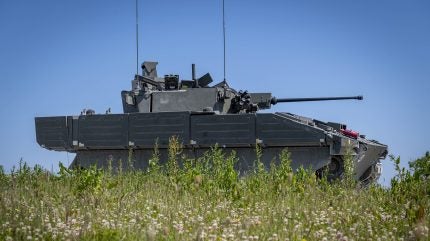
The British Army’s Ajax armoured cavalry programme will not reach its initial operating capability (IOC) until December 2025, according to a timeline released on 22 July 2024, by the UK’s new Labour Government, which is beginning to grapple with a number of troubling legacy procurements.
According to a UK Parliament report published in March 2023, the UK MoD had a firm price contract of £5.5bn ($6.9bn) with GDUK to deliver 589 vehicles. It is understood that IOC is achieved once 50 units of the 589 total have been delivered, which will see 27 used by a deployable squadron, with the remaining 23 used by the British Army for crew and maintainer training.
By January 2024, more than six months had passed since the last of the 44 units delivered in June 2023 had been handed over, as crews continued familiarisation with the platform.
In total the programme is intended to deliver the platforms across six variants, incorporating the Ajax infantry fighting vehicle, Apollo armoured recovery vehicle, Ares armoured personnel carrier, Argus reconnaissance vehicle, Athena command post vehicle, and Atlas engineering vehicle into British Army service.
In January 2024 it was disclosed that 152 Ajax programme vehicles had been built, representing just over 25% of the planned total fleet number. The latest standard of the vehicle, known as Capability Drop 3, had been accepted” by the UK Ministry of Defence, with deliveries reported to be “on track” to achieve IOC.
The British Army: rescue and renew, or left to ruin?
The British Army’s Ajax armoured cavalry programme is one of a quartet of critical land domain procurement efforts that will form the structure and shape of the service over the coming generation, along with the Boxer mechanised infantry vehicle, the Challenger 3 main battle tank, and RCH 155 self-propelled howitzers.
However, it is accepted that the British Army’s inventory and military capability is drastically reduced, with the UK military as a whole recently falling foul of a rare rebuke from the United States.
Speaking at the RUSI Land Warfare Conference on 23 July, Chief of the Defence Staff Adm Tony Radakin reportedly admitted the British Army was in poor condition, contending against underinvestment and a range of other troubling issues.
Much, or potentially all, of the British Army’s AS90 155mm artillery has been donated to Ukraine, with the small number of interim Archer 155mm systems not due to reach IOC until October 2024.
The number of available Challenger 2 tanks as well is far below the inventory fleet strength, while its legacy Warrior infantry fighting vehicles are due to begin leaving service in 2025.
A significant weight of responsibility then will rest with the Ajax programme and whether it can overcome serious issues encountered earlier in its development, including inducing hearing damage among crew members, to deliver upon its intended capability.




